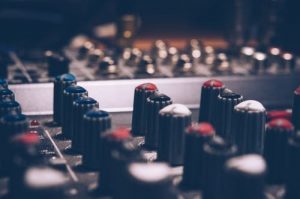Musings at the Mic
– BY SCOTT THOMAS
“Can I build a home studio for under $300?” 
Recently, I was discussing home studio tips and that question was posed to me. True, there was a time when a home studio was rare in the world of voice overs. Back in the day, the idea of a $300 home studio would’ve sent most casting directors into a fit of laughter. But in light of all the advances over the years, the answer to the question today is a resounding yes.
Now, don’t get your hopes up about how cheap and easy it is to create a home studio, and off you go making six figures. I’m referring to a “starter kit” here, if you will.
If you’re serious about voice over work as a career, you have to come to terms with the fact that this is a business, and like all businesses, you will have to spend money to make money. Understand that you will be investing in your career for your entire career.
That said…you have to start somewhere, so let’s get this ball rollin’ and dive into some home studio tips.
Your recording space is as critical as your mic.
Having a “clean” recording is not an option – it’s rule one. When you send your recording off to another professional, any and all audio issues could very well become glaring indictments on your level of professionalism and experience. The last thing you want is some sort of buzz, hiss or hum under your read (and God help you if there’s a lawn mower or dog barking in the background).
One of the first things to determine in your home studio is your noise floor. In layman’s terms, the noise floor is a measurement of how much background noise your studio puts out. To determine your studio’s noise floor, simply record your room for thirty seconds (without you in it). Your noise floor should be -60dB or better (quieter).
There’s sound proofing, and there’s sound treating.
When creating a home studio, you gotta’ know the difference. Sound treating deals with reducing sound reflections within the recording space – or putting it simply, reducing that echo effect you get in an empty room. Sound proofing is reducing levels of exterior sound from getting inside your recording space. The former is much easier and much cheaper, so let’s go there first.
If you have a carpeted closet with plenty of clothes and space for you to record, that could work nicely (until you get the itch to go to Home Studio Phase Two. But I digress). Other cheap forms of sound treating a recording space include moving blankets, drapes, carpet & even egg cartons. If you have a flexible budget and care about aesthetics, acoustic tiles can be found at a decent price, depending on the size of your area.
Exterior sounds will go right through acoustic tiles. Duh.
Sound proofing a recording space is much more involved than sound treating. You’ll never block 100% of exterior sounds from entering your studio, but if you achieve that -60dB level with your noise floor, you’re on the right track. If, however, you have to deal with planes, trains & automobiles, lawn mowers and barking dogs on a regular basis, you’ll have to do your research on sound proofing fundamentals. One of the best forms of sound-proofing is mass, so consider lining walls with mass loaded vinyl before adding acoustic tiles. There is no such thing as a completely sound-proof room, but the MLV blocks out 80 to 90 percent of the exterior noise, so it works for my studio.
Just remember that upgrades will be a constant part of your voice over journey. So get yourself that mic, plug it in and start recording your voice. Find a good coach, and practice, practice, practice. Listen to the critiques, and then practice some more. Lather, rinse, repeat. Before you know it, you’ll be writing blogs about how you did it.
